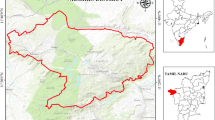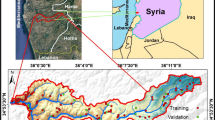Abstract
A landslide susceptibility zonation (LSZ) map helps to understand the spatial distribution of slope failure probability in an area and hence it is useful for effective landslide hazard mitigation measures. Such maps can be generated using qualitative or quantitative approaches. The present study is an attempt to utilise a multivariate statistical method called binary logistic regression (BLR) analysis for LSZ mapping in part of the Garhwal Lesser Himalaya, India, lying close to the Main Boundary Thrust (MBT). This method gives the freedom to use categorical and continuous predictor variables together in a regression analysis. Geographic Information System has been used for preparing the database on causal factors of slope instability and landslide locations as well as for carrying out the spatial modelling of landslide susceptibility. A forward stepwise logistic regression analysis using maximum likelihood estimation method has been used in the regression. The constant and the coefficients of the predictor variables retained by the regression model have been used to calculate the probability of slope failure for the entire study area. The predictive logistic regression model has been validated by receiver operating characteristic curve analysis, which has given 91.7% accuracy for the developed BLR model.




Similar content being viewed by others
References
Anbalagan R (1992) Landslide hazard evaluation and zonation mapping in mountainous terrain. Eng Geol 32:269–277
Arora MK, Das Gupta AS, Gupta RP (2004) An artificial neural network approach for landslide hazard zonation in the Bhagirathi (Ganga) Valley, Himalayas. Int J Remote Sens 25(3):559–572
Atkinson PM, Massari R (1998) Generalized linear modelling of susceptibility to landsliding in the central Apennines, Italy. Comput Geosci 24:373–385
Barredo J, Benavides A, Hervas J, van Westen C (2000) Comparing heuristic landslide hazard assessment techniques using GIS in the Tirajana basin, Gran Canaria Island, Spain. JAG 2(1):9–23
Begueria S, Lorente A (2002) Landslide hazard mapping by multivariate statistics: comparison of methods and case study in the Spanish Pyrenees. Technical report. Instituto Pirenaico de Ecologia, Saragossa, p 19
Carrara A (1983) Multivariate models for landslide hazard evaluation. Math Geol 15(3):403–427
Carrara A (1988) Landslide hazard mapping by statistical methods: a black-box approach. In: Proceeding of workshop on natural disaster in European Mediterranean Countries, Perugia, Italy, pp 205–224
Carrara A, Cardinalli M, Detti R, Guzzetti F, Pasquvi V, Reichenbach P (1990) Geographical information systems and multivariate models in landslide hazard evaluation. In: Proceeding of ALPS 90, Alpine Landslide Practical Seminar, Sixth International Conference and Field workshop on landslides, Milan, Italy, 31 August–12 September 1990, pp 17–28
Carrara A, Cardinalli M, Detti R, Guzzetti F, Pasquvi V, Reichenbach P (1991) GIS techniques and statistical models in evaluating landslide hazard. Earth Surf Processes Landf 16(5):427–445
Carrara A, Cardinalli M, Guzzetti F (1992) Uncertainty in assessing landslide hazard and risk. ITC J 2:172–183
Carrara A, Crosta G, Frattini P (2003) Geomorphological and historical data in assessing landslide hazard. Earth Surf Processes Landf 28:1125–1142
Dai FC, Lee CF (2002) Landslide characteristics and slope instability modelling using GIS in Lantau Island, Hong Kong. Geomorphology 42:213–238
Dai FC, Lee CF, Li J, Xu ZW (2001) Assessment of landslide susceptibility on the natural terrain of Lantau Island, Hong Kong. Environ Geol 40:381–391
Davis JC, Ohlmacher GC (2002) Landslide hazard prediction using generalized logistic regression. In: Proceedings of 8th Annual Conference of the International Association for Mathematical Geology, Berlin, Germany, pp 501–506
Donati L, Turrini MC (2002) An objective method to rank the importance of the factors predisposing to landslides with the GIS methodology: application to an area of the Apennines (Valnerina; Perugia, Italy). Eng Geol 63:277–289
Gorsevski PV, Gessler P, Foltz RB (2000a) Spatial prediction of landslide hazard using discriminant analysis and GIS. In: Proceedings of GIS in the Rockies 2000: Conference and Workshop Applications for the 21st Century, Denver, Colorado, 25 – 27 September 2000, p 10
Gorsevski PV, Gessler PE, Foltz RB (2000b) Spatial prediction of landslide hazard using logistic regression and GIS. In: Proceedings of the 4th International Conference on Integrating GIS and Environmental Modelling: Problems, Prospects and Research Needs, Banff, Alberta, 2–8 September 2000, p 10
GSI (2005) Geological quadrangle map 53J. Geological Survey of India, Calcutta
Gupta RP, Joshi BC (1990) Landslide hazard zoning using the GIS approach—a case study from the Ramganga Catchment, Himalayas. Eng Geol 28:119–131
Gupta V, Sah MP, Virdi NS, Bartarya SK (1993) Landslide hazard zonation in the Upper Satlej Valley, District Kinnaur, Himachal Pradesh. J Himal Geol 4:81–93
Gupta RP, Saha AK, Arora MK, Kumar A (1999) Landslide hazard zonation in a part of Bhagirathy Valley, Garhwal Himalayas, using integrated remote sensing—GIS. J Himal Geol 20(2):71–85
Hair JF, Black B, Babin B, Anderson RE, Tatham RL (2006) Multivariate data analysis, 6th edn. Prentice Hall, London, p 928
Hanley JA, McNeil BJ (1982) The meaning and use of the area under a receiver operating characteristic (ROC) curve. Radiology 143(1):29–36
Johnson DE (1998) Applied multivariate methods for data analysis. Duxbury, Pacific Grove
Kanungo DP, Arora MK, Sarkar S, Gupta RP (2006) A comparative study of conventional, ANN black box, fuzzy and combined neural and fuzzy weighting procedures for landslide susceptibility zonation in Darjeeling Himalayas. Eng Geol 85:347–366
Kleinbaum DG (1994) Logistic regression: a self learning text. Springer, New York, p 282
Lee S (2005) Application of logistic regression model and its validation for landslide susceptibility mapping using GIS and remote sensing data. Int J Remote Sens 26(7):1477–1491
Lee S, Evangelista DG (2005) Landslide susceptibility mapping using probability and statistics models in Baguio City, Philippines. In: Proceedings of the 31st International Symposium on remote sensing of environment, 20–24 June, 2005, St. Petersburg, Russia, p 4
Lee S, Min K (2001) Statistical analysis of landslide susceptibility at Yongin, Korea. Environ Geol 40:1095–1113
Lee S, Ryu JH, Lee MJ, Won JS (2006) The application of artificial neural networks to landslide susceptibility mapping at Janghung, Korea. Math Geol 38(2):199–220
Mathew J, Jha VK, Rawat GS (2007) Weights of evidence modelling for landslide hazard zonation mapping in part of Bhagirathi valley, Uttarakhand. Curr Sci 92(5):628–638
NRSA (2001) Landslide hazard zonation mapping along the corridors of the pilgrimage routes in Uttaranchal Himalaya. Technical document, NRSA, Department of Space, India
Ohlmacher GC, Davis JC (2003) Using multiple logistic regression and GIS technology to predict landslide hazard in northeast Kansas, USA. Eng Geol 69:331–343
Pachauri AK, Pant M (1992) Landslide hazard mapping based on geological attributes. Eng Geol 32:81–100
Panikkar SV (1995) Landslide hazard zonation in Mussoorie Hills. Ph.D. Thesis, Department of Earth Sciences, IIT Bombay, p 136
Panikkar SV, Subramanyan V (1996) A geomorphic evaluation of landslides around Dehradun and Mussoorie, Uttar Pradesh, India. Geomorphology 15:169–181
Philip G, Ravindran KV, Mathew J (2003) Mapping the Nidar ophiolite complex of the Indus Suture Zone, Northwestern-Trans Himalaya using IRS-1C/1D data. Int J Remote Sens 24(24):4979–4994
Saha AK, Gupta RP, Arora MK (2002) GIS-based landslide hazard zonation in a part of the Himalayas. Int J Remote Sens 23:357–369
Saha AK, Gupta RP, Sarkar I, Arora MK, Csaplovics E (2005) An approach for GIS-based statistical landslide susceptibility zonation—with a case study in the Himalayas. Landslides 2:61–69
Suzen ML (2002) Data driven landslide hazard assessment using geographical information systems and remote sensing. Ph.D. Thesis, Middle East Technical University, Turkey, p 196
Süzen M, Doyuran V (2004) A comparison of the GIS based landslide susceptibility assessment methods: multivariate versus bivariate. Environ Geol 45(5):665–679
Valdiya KS (1980) Geology of Kumaun lesser Himalaya. Wadiya Institute of Himalayan Geology, Dehradun, p 291
Zweig MH, Campbell G (1993) Receiver operating characteristic plots: a fundamental evaluation tool in clinical medicine. Clinical Chemistry 39(4):561–577
Acknowledgements
The authors sincerely thank Dr. V. Jayaraman, Director, NNRMS/EOS, Department of Space, ISRO, India, for permitting them to carry out the study. JM thanks Dr. K. P. Sharma, Head, RRSSC, Dehradun, for the constant encouragement and motivation. Dr. N. S. Virdi, Former Director and Dr. G. Philip, Scientist, Wadia Institute of Himalayan Geology, Dehradun, extended their help and support for carrying out this study. Prof. M. L. Süzen, METU, Turkey and Prof. John C. Davis, Department of Petroleum Engineering, Leoben, Austria provided valuable suggestions on logistic regression model.
Author information
Authors and Affiliations
Corresponding author
Rights and permissions
About this article
Cite this article
Mathew, J., Jha, V.K. & Rawat, G.S. Landslide susceptibility zonation mapping and its validation in part of Garhwal Lesser Himalaya, India, using binary logistic regression analysis and receiver operating characteristic curve method. Landslides 6, 17–26 (2009). https://doi.org/10.1007/s10346-008-0138-z
Received:
Accepted:
Published:
Issue Date:
DOI: https://doi.org/10.1007/s10346-008-0138-z




